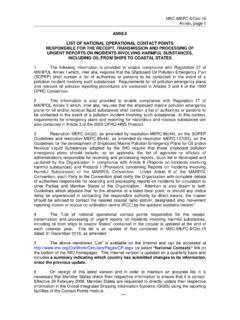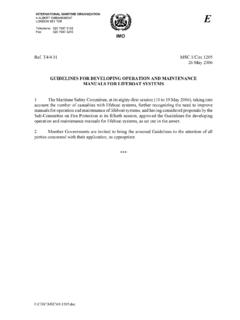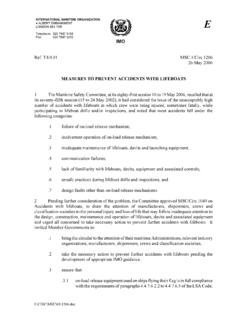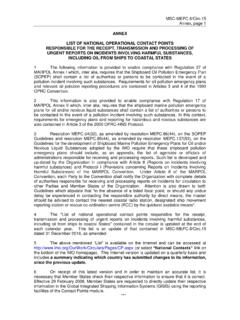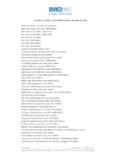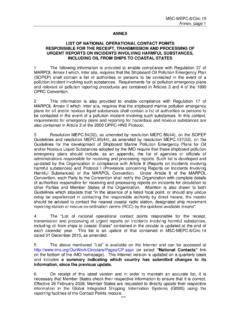Transcription of IMO Frequently Asked Questions Implementing the Ballast ...
1 IMO Frequently Asked Questions Implementing the Ballast Water Management Convention The International Convention for the Control and Management of Ships' Ballast Water and Sediments, 2004, entered into force globally on 8 September 2017. The International Maritime Organization (IMO) responds below to Frequently Asked Questions about the BWM Convention and its provisions, and what the entry into force means for international shipping. What is the Ballast Water Management Convention? The Ballast Water Management Convention or BWM Convention (full name International Convention for the Control and Management of Ships' Ballast Water and Sediments, 2004) is a treaty adopted by the International Maritime Organization (IMO) in order to help prevent the spread of potentially harmful aquatic organisms and pathogens in ships' Ballast water.
2 From 8 September 2017, ships must manage their Ballast water so that aquatic organisms and pathogens are removed or rendered harmless before the Ballast water is released into a new location. This will help prevent the spread of invasive species as well as potentially harmful pathogens. IMO is the United Nations specialized agency with responsibility for developing global standards for ship safety and security and for the protection of the marine environment and the atmosphere from any harmful impacts of shipping. When did the BWM Convention enter into force? The BWM Convention entered into force globally on 8 September 2017. Which ships does the convention apply to? The convention applies to ships registered under contracting Parties to the BWM Convention, which take up and use Ballast water during international voyages.
3 What about ships registered under a flag which hasn't ratified the BWM. Convention? Such ships may not be issued with the relevant certificates. However, port States which are Parties will expect the ships to comply with the requirements of the Convention, so as to ensure no more favourable treatment is given to such ships. What do ships need to do, now the treaty is in force? From the date of entry into force, ships in international traffic are required to manage their Ballast water and sediments to a certain standard, according to a ship-specific Ballast water management plan. Ships have to carry: A Ballast water management plan - specific to each ship, the Ballast water management plan includes a detailed description of the actions to be taken to implement the Ballast water management requirements and supplemental Ballast water management practices.
4 A Ballast water record book - to record when Ballast water is taken on board;. circulated or treated for Ballast water management purposes; and discharged into the sea. It should also record when Ballast water is discharged to a reception facility and accidental or other exceptional discharges of Ballast water; and An International Ballast Water Management Certificate (ships of 400 gt and above). this is issued by or on behalf of the Administration (flag State) and certifies that the ship carries out Ballast water management in accordance with the BWM Convention and specifies which standard the ship is complying with, as well as the date of expiry of the Certificate. What are the Ballast water management standards? There are two Ballast water management standards (D-1 and D-2). The D-1 standard requires ships to exchange their Ballast water in open seas, away from coastal areas.
5 Ideally, this means at least 200 nautical miles from land and in water at least 200 metres deep. By doing this, fewer organisms will survive and so ships will be less likely to introduce potentially harmful species when they release the Ballast water. The D-2 standard specifies the maximum amount of viable organisms allowed to be discharged, including specified indicator microbes harmful to human health. From the date of entry into force of the BWM Convention, all ships must conform to at least the D-1 standard; and all new ships, to the D-2 standard. Eventually, all ships will have to conform to the D-2 standard. For most ships, this involves installing special equipment to treat the Ballast water. IMO Member Governments, meeting in the Marine Environment Protection Committee (MEPC), have agreed an implementation timetable for existing ships, linked to the ship's International Oil Pollution Prevention Certificate (IOPPC) renewal survey.
6 What does the new schedule for implementation say? In essence, the schedule for implementation which has been agreed by the MEPC means that compliance with the D-2 standard will be phased in over time for individual ships, up to 8. September 2024. Over time, more and more ships will be compliant with the D-2 standard. (See the infographic). From 8 September 2017: New ships must meet the D-2 standard. All ships must have: - A Ballast water management plan;. - A Ballast water record book; and - An International Ballast Water Management Certificate. Existing ships must meet at least the D-1 ( Ballast water exchange) standard; they may also choose to install a Ballast water management system or otherwise meet the D-2 (discharge) standard but this is not mandatory until the corresponding compliance date. IOPPC Renewal survey after 8 September 2019.
7 A ship undergoing a renewal survey linked to the ship's International Oil Pollution Prevention Certificate after 8 September 2019 will need to meet the D-2 standard by the date of this renewal survey. IOPPC Renewal survey between 8 September 2017 and 8 September 2019. - If the previous IOPPC renewal survey was between 8 September 2014 and 8. September 2017, then the ship must comply with D-2 standard by this renewal survey. - If the previous IOPPC renewal survey was before 8 September 2014, then the ship can wait until the next renewal survey (which will be after 8 September 2019). What if the ship doesn't have an IOPPC renewal survey? The ship should meet the D-2 standard at a date determined by its flag State, but not later than 8 September 2024. 3. What is the real difference between the D-1 and D-2 standards?
8 The difference is that D-1 relates to Ballast water exchange, while D-2 specifies the maximum amount of viable organisms allowed to be discharged, including specified indicator microbes harmful to human health. D-1 standard The D-1 standard requires ships to conduct an exchange of Ballast water such that at least 95% of water by volume is exchanged far away from the coast. D-2 standard The D-2 standard specifies that ships can only discharge Ballast water that meets the following criteria: less than 10 viable organisms per cubic metre which are greater than or equal to 50 micrometres in minimum dimension;. less than 10 viable organisms per millilitre which are between 10 micrometres and 50 micrometres in minimum dimension;. less than 1 colony-forming unit (cfu) per 100 mililitres of Toxicogenic Vibrio cholerae.
9 Less than 250 cfu per 100 millilitres of Escherichia coli; and less than 100 cfu per 100 milliliters of Intestinal Enterococci. How will ships' compliance be checked? Ships may be subject to port State control in any port or offshore terminal of a Party to the BWM Convention. This inspection may include verifying that there is onboard a valid Certificate and an approved Ballast water management plan; inspection of the Ballast water record book;. and/or sampling of the ship's Ballast water, carried out in accordance with the Guidelines for Ballast water sampling (G2). However, the time required to analyse the samples shall not be used as a basis for unduly delaying the operation, movement or departure of the ship. How are Ballast water management systems approved? Regulation D-3 of the Convention covers approval requirements for Ballast water management systems.
10 Ballast water management systems must be approved by the Administration taking into account IMO Guidelines. Revised Guidelines for approval of Ballast water management systems (G8) were adopted in 2016 and have now been reworked as a draft mandatory Code for approval of Ballast water management systems (BWMS Code), expected to be adopted by MEPC 72 in April 2018. The BWMS Code includes robust test and performance specifications as well as detailed requirements for type approval reporting and control and monitoring equipment. Ballast water management systems which make use of Active Substances or preparations containing one or more Active Substances must in addition be approved by IMO, in accordance with the Procedure for approval of Ballast water management systems that make use of Active Substances (G9). Has the BWM Convention implementation been delayed by IMO?
